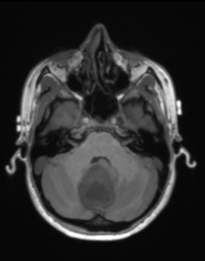Pilocytic astrocytoma
The pilocytic astrocytoma, or juvenile pilocytic astrocytoma, is a brain tumor that occurs more often in children and young adults with a strong association with Neurofibromatosis type I. It usually arises in the cerebellum, near the brainstem, in the hypothalamic region, or the optic chiasm, but they may occur in any area where astrocytes are present, including the cerebral hemispheres and the spinal cord. Pilocytic astrocytomas are usually slow growing and benign. These neoplasms are associated with the formation of a single (or multiple) cyst(s), and can become very large.
Epidemiology
Pilocytic astrocytomas are rare and only make up 0.6-5.1% of all intracranial tumors. They are, however, the most common primary brain tumor of childhood, accounting for up to 85% of all cerebellar astrocytomas. 75% occur in patients under the age of 20, with a peak incidence around 9 years. There is no significant gender preponderance.
MRI features
T1: Shows a solid component that is iso- to hypointense compared to adjacent brain and a cystic component with a fluid like signal, unless hemorrhagic.
T1 C+: Pilocytic astrocytomas tend to enhance vividly on contrast imaging. Roughly half of cases have cyst wall enhancement.
T2: The solid component is hyperintense compared to adjacent brain, the cystic component shows a high signal



